The Women's Camp
 |
| Ravensbrück. |
I wrote an
article on Mauthausen a while back, which was one of the vilest concentration camps in the Reich system. There, they worked the male inmates to death, including a notorious punishment exercise where they had to carry large stones up a steep stairway. This time, it is the ladies' turn. There was exactly one camp in the concentration camp system just for women, and it was known as
Ravensbrück.
Let's get an overview of what Ravensbrück was all about.
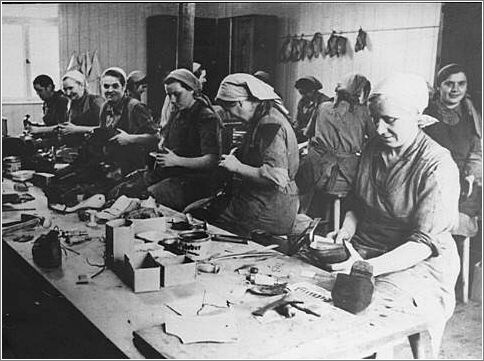 |
| Women prisoners working at Ravensbrück. |
Like most concentration camps, Ravensbrück was named after the town where it was located, some fifty miles north of Berlin. The camp was erected by 1938, one of the earlier camps, and was designed from the beginning to house females only. The facility opened in May 1939 and was greatly expanded after the influx of new prisoners from Poland. It was a "show camp," maintained neatly for much of its early existence. There were flowers and birdcages and beautifully manicured yards. This was done to impress the International Red Cross, which insisted on inspecting the camp.
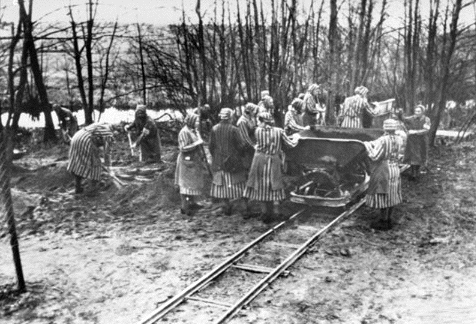 |
| Women worked outside clearing the ground, too. |
However, there was horror behind the impeccably arranged gardens. It is estimated that some 130,000 female prisoners passed through Ravensbrück, and when we say "passed through," we don't mean that the next stop was a trip home. Of that total, about 3,500 inmates were alive when the camp was liberated on 29-30 April 1945. It is estimated that the total number of women who survived passage through Ravensbrück was no more than 15,000, but nobody really knows with precision. Figures vary wildly depending upon the source and how you define things. Let's just say that tens and tens of thousands of women perished there.
 |
| A heavy roller pulled by inmates for road construction, now left as a memorial (Bartocha, Benno, Federal Archive, Bild 183-1985-1105-310). |
Most of the women who passed through Ravensbrück were Polish, but there also were inmates from the USSR, France, Holland, and Germany itself. Basically, they came from everywhere the Germans occupied. It is estimated that 26,000 were there because they were Jewish.
Many of the women perished from overwork and other maltreatment. There was a gas chamber staffed by male inmates at an adjacent camp, but that came late in the process and apparently only accounted for 2,200 of the victims.
 |
| Victims of Ravensbrück. You will notice that some wear crosses or are nuns - women of all sorts perished in the death camps. |
The women at the camp worked for several German companies: electrical engineering company Siemens & Halske, which built things like electrical generators (patented by Werner von Siemens in 1867) and motors; Daimler-Benz (now Mercedes-Benz); and AEG, among others. There was lots of need for young women, and some were sent to brothels in other prison camps. There were reports of rapes and other sexual assaults, but the use of female guards cut down on the incidence of that - one would assume.
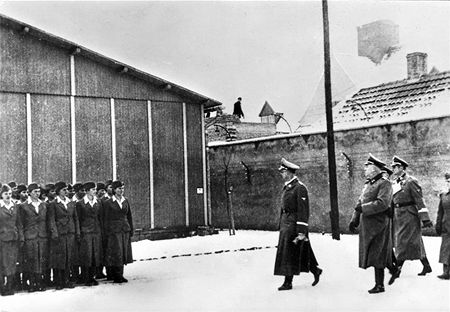 |
| Inspection of the female guards at Ravensbrück. |
There was a lot of horror at Ravensbrück, but sometimes the true horror is best expressed by zeroing in on a tiny fraction of it. There was a group of 72 Polish Catholic women who were subjected to medical experiments. These involved implanting glass and other debris into their legs to mimic certain injuries. As the wounds festered, the concentration camp staff then performed various treatments on them to see what would work and what would not. The women were called "rabbits" because the pain of the experiments forced them to hop around.
 |
| Reinhard Heydrich was in charge of the concentration camp system until his assassination in mid-1942. |
The impetus behind these experiments was the assassination of SS Gauleiter
Reinhard Heydrich in Prague in June/July 1942. Heydrich was a truly sinister character who in large part drew up the blueprints for how the Holocaust was carried out. Heydrich took a week to die and was in pain throughout after having a grenade thrown at him. The doctor who treated Heydrich, Karl Gebhardt, did not believe in the efficacy of sulfa drugs, so he refused to use them on Heydrich despite indications they were suitable. While sulfa drugs were crude, they were the best thing to use to avoid infection before penicillin. Gebhardt's dismissal of them may have contributed to Heydrich's death, or so thought Adolf Hitler at any rate. Gebhardt, thus highly motivated to prove that he was right (he wasn't), experimented on the women to try to prove that he was not, in fact, the quack that he apparently was.
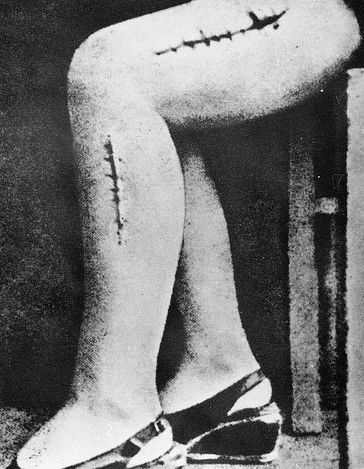 |
| Cruel experiments were performed on one of the "rabbits" shown here. There are many, many other pictures just like this, many much more gruesome. |
Many of the rabbit women perished in the camp, but a few survived. The Germans were going to kill them, but the rabbits vanished during an electrical shutdown arranged by some of the inmates who worked with the electrical grid. The women then hid around the camp until the war ended a short time later. There were other women used in other gruesome experiments, but they did not survive. This involved chilling attempts to remove an inmate's bone and replace it with someone else's. No, that cannot work.
 |
| The gas chambers at Ravensbrück. |
A small group of the "rabbits" - five, apparently, as of this writing - survives to this day. One is Stanislaus Sledziejowska-Osiczko. She recalls that the communist Polish government did not want to help them after the war but finally allowed the rabbits to travel to the United States for treatment. Unfortunately, they then had to return to communist Poland, where they remain.
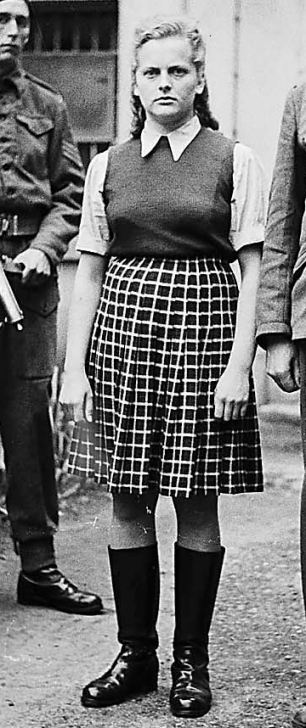 |
| SS Guard (Aufseherin) Irma Grese when she was arrested. |
There is too much horror in a concentration camp to really convey it in a single article, or a single book, or even a volume of books. The guards were brutal, and among the most brutal were the female camp guards used whips on the inmates.
 |
| In the dock during the trial in Hamburg. |
I have written about them elsewhere, but some stand out and merit special attention: Irma Grese, "the Hyena"; Elfriede Muller, "The Beast of Ravensbrück"; and the overseers such as Luise Brunner.
 |
| Greta Bösel on trial (Photo: ullstein bild Dtl. / Contributor / ullstein bild). |
Greta Bösel (née Mueller) was one of the worst. She personally picked out the inmates for the gas chamber if they didn't meet her work requirements as Arbeitseinsatzführerin (Work Input Overseer). She said, "If they [prisoners] cannot work, let them rot." With Red Army troops nearby, she fled with her husband while the women prisoners were being marched through the cold and snow to another camp further west. Perhaps she thought, like many other Germans, that the British would be more lenient. However, they took her into custody and put her in the dock at the First Ravensbruck Trial. Convicted, Greta faced her punishment. The Allies executed Greta Bösel on 3 May 1947.
 |
| The sentence is passed, your presence is no longer necessary. |
Trials were held from 1946 to 1948 (the Hamburg Ravensbrück Trials) and sixteen of the female guards were sentenced to death. Some of the female camp guards have been extradited from the United States as recently as 2006, when Elfriede Rinkel, a guard from 1944 to 1945, was sent back.
 |
| The Ravensbrück defendants, Irma Grese in the foreground. |
The last, brutal gesture by the Germans occurred in March 1945. The Red Army was just across the river, and little stood between their tanks and the camp. The SS ordered all of the women who could to march in a column toward Mecklenburg. It turned into a death march in the middle of winter and was absolutely pointless. The Soviets liberated both the camp and the women who had marched to nowhere within a few hours of each other. Today, there is a memorial on the campsite near Schwedtsee Lake, and many of the camp buildings have been re-purposed.
2021
















No comments:
Post a Comment